#auditory learner
Explore tagged Tumblr posts
Text
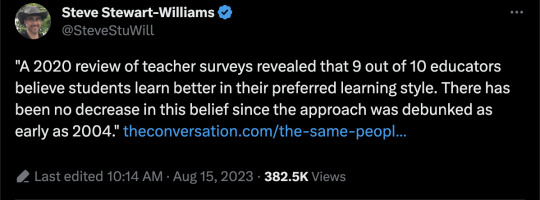
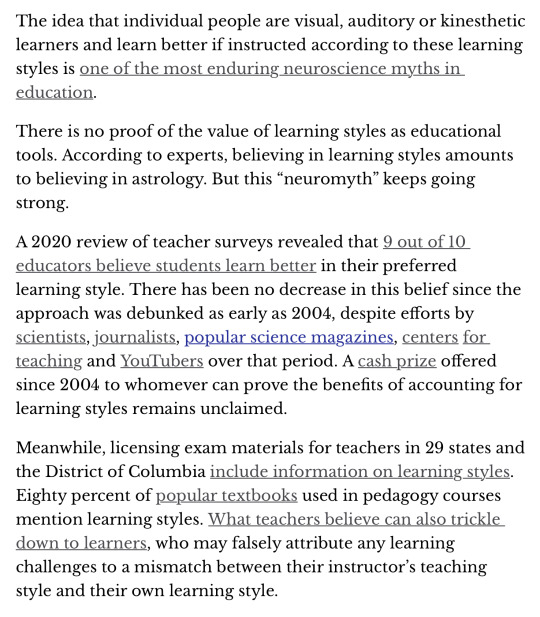
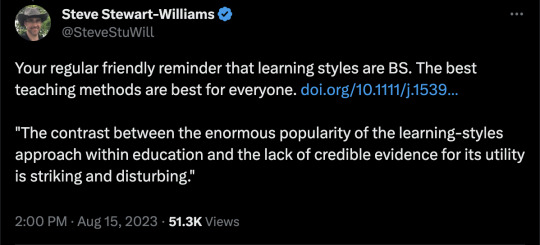
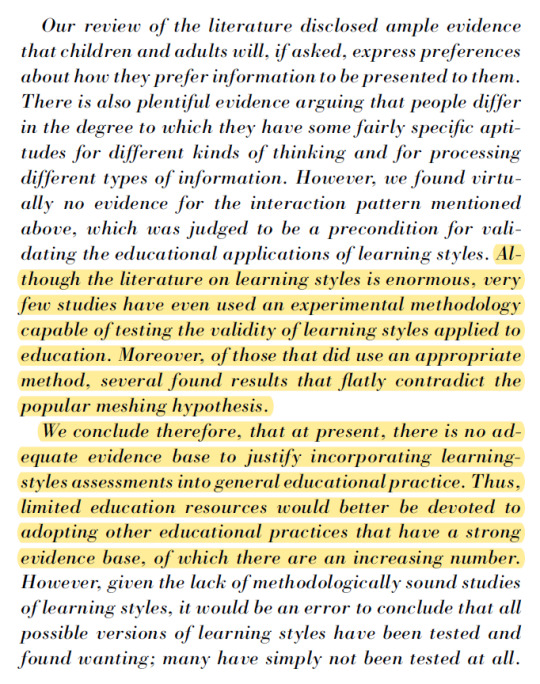
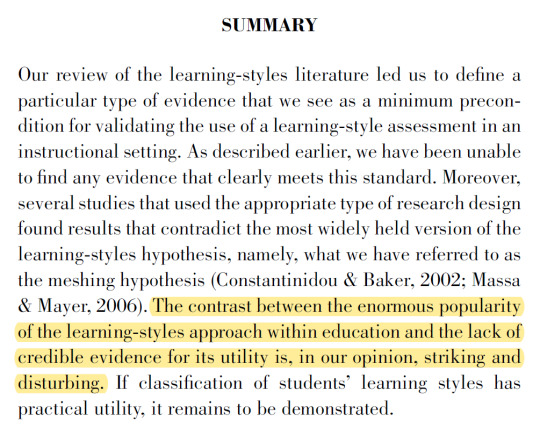
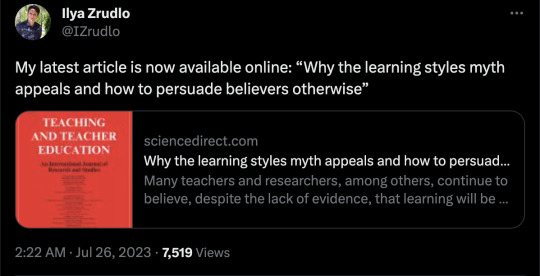
Abstract Many teachers and researchers, among others, continue to believe, despite the lack of evidence, that learning will be more effective if educators match their teaching approaches to students’ alleged learning styles. Scholars have called for more research on why the belief in learning styles is so appealing. This conceptual paper suggests four moral intuitions or sensibilities that underlie the appeal: (1) the desire for rational control, (2) our sense of justice, (3) the feeling that everyone is unique, and (4) reverence for the natural. Speaking to these intuitions could strengthen efforts to debunk the myth of learning styles in teacher education.
[..] Experts aren’t sure how the concept spread, but it might have had something to do with the self-esteem movement of the late ‘80s and early ‘90s. Everyone was special—so everyone must have a special learning style, too. Teachers told students about it in grade school. “Teachers like to think that they can reach every student, even struggling students, just by tailoring their instruction to match each student’s preferred learning format,” said Central Michigan University’s Abby Knoll, a PhD student who has studied learning styles. (Students, meanwhile, like to blame their scholastic failures on their teacher’s failure to align their teaching style with their learning style.)
Either way, “by the time we get students at college,” said the Indiana University professor Polly Husmann, “they’ve already been told ‘You’re a visual learner.’” Or aural, or what have you.
The thing is, they’re not. Or at least, a lot of evidence suggests that people aren’t really one certain kind of learner or another. In a study published last month in the journal Anatomical Sciences Education, Husmann and her colleagues had hundreds of students take the Vark questionnaire to determine what kind of learner they supposedly were. The survey then gave them some study strategies that seem like they would correlate with that learning style. Husmann found that not only did students not study in ways that seemed to reflect their learning style, those who did tailor their studying to suit their style didn’t do any better on their tests.
Husmann thinks the students had fallen into certain study habits, which, once formed, were too hard to break. Students seemed to be interested in their learning styles, but not enough to actually change their studying behavior based on them. And even if they had, it wouldn’t have mattered.
“I think as a purely reflective exercise, just to get you thinking about your study habits, [Vark] might have a benefit,” Husmann said. “But the way we’ve been categorizing these learning styles doesn’t seem to hold up.”
Another study published last year in the British Journal of Psychology found that students who preferred learning visually thought they would remember pictures better, and those who preferred learning verbally thought they’d remember words better. But those preferences had no correlation to which they actually remembered better later on—words or pictures. Essentially, all the “learning style” meant, in this case, was that the subjects liked words or pictures better, not that words or pictures worked better for their memories.
In other words, “there’s evidence that people do try to treat tasks in accordance with what they believe to be their learning style, but it doesn’t help them,” says Daniel Willingham, a psychologist at the University of Virginia. In 2015, he reviewed the literature on learning styles and concluded that “learning styles theories have not panned out.”
That same year, a Journal of Educational Psychology paper found no relationship between the study subjects’ learning-style preference (visual or auditory) and their performance on reading- or listening-comprehension tests. Instead, the visual learners performed best on all kinds of tests. Therefore, the authors concluded, teachers should stop trying to gear some lessons toward “auditory learners.” “Educators may actually be doing a disservice to auditory learners by continually accommodating their auditory learning style,” they wrote, “rather than focusing on strengthening their visual word skills.”
In our conversation, Willingham brought up another study, published in 2009, in which people who said they liked to think visually or verbally really did try to think that way: Self-proclaimed visualizers tried to create an image, and self-proclaimed verbalizers tried to form words. But, there was a rub, he said: “If you’re a visualizer and I give you pictures, you don’t remember pictures any better than anyone who says they’re verbalizer.”
This doesn’t mean everyone is equally good at every skill, of course. Really, Willingham says, people have different abilities, not styles. Some people read better than others; some people hear worse than others. But most of the tasks we encounter are only really suited to one type of learning. You can’t visualize a perfect French accent, for example.
==
Considering the sources of teacher training, Ed Schools, are extremely highly ideological, the perpetuation of this "neuromyth" is probably not an accident or misunderstanding.
These are the schools that have attached quasi-religious overtones to their preferred, but ineffective, process of teaching kids to read, and have been denying evidence-based methods for decades.
#learning styles#pseudoscience#education#corruption of education#neuroscience#myths#science#VARK#visual learner#auditory learner#reading learner#kinesthetic learner#junk science#religion is a mental illness
80 notes
·
View notes
Text
Radio Kid
What do you remember about the radio?
You hear the term iPad kids these days. Or children who learned how to operate iPads before they learned to speak. Consequently, they develop an addiction to this device. It doesn’t seem to be a term of endearment, but rather a derogatory term. These iPad kids don’t have a clue about how the real word is. I remember hearing the same kind of language when I was a kid but attached to Television.…

View On WordPress
#Addiction#Alabama#auditory learner#Childhood#early childhood development#ipad addiction#ipad kids#Learning#Narrative#nostalgia#old time radio#radio shows#self awareness#self help#Southern Living#vintage radio#Zane Wells
0 notes
Text
Accidentally learning how to speak in different accents bc of whatever character I’m obsessed with listening to at the moment
#I got pretty good at imitating Viktor’s Czech accent cuz I was watching his scenes so much lol#and now I’m getting pretty good at Scottish accent bc of Pippin#being an auditory learner has its perks lmao#viktor arcane#pippin took#lotr#lord of the rings#arcane#rhi rambles
20 notes
·
View notes
Note
Kind of a weird question but do you have any fic recommendations? Your writing is really fun and I tend to trust ppl's taste when they have good writing themselves lol
So do you have any that you enjoy and would recommend we check out?
I actually don't really read fanfiction LOL... I like Head---Ache and Emthimofnight's fics but I don't really read much!! Eclipsed-Jester also has good fics ^^
I'm sorry if this wasn't the answer you were expecting lol, but TYSM for saying my writing is good!!!
9 notes
·
View notes
Text
looking at an article to figure out how to do something, getting completely overwhelmed with all the words, then seeing there’s a video at the bottom with the exact same information laid out and thinking “well why didn’t you just START with that?”
#i am but a small child#trying to figure out imported transitions from davinci resolve#explain it to me like i have never seen a computer in my life#articles#how to#does that make me an auditory learner#i can never remember which is which#editor
5 notes
·
View notes
Text
YouTube Watch History and its search functions(both the one inside yt and the one in My Activity(google)) used to be a genuinely reliable feature. Still can't wrap my head around the reasons they had to make it into this unusable garbage we have today.
#think i might have to make an xlsx or docx for my history#i technically already have a “logbook” but i have very few of them saved there#that was mostly for when i write while i'm listening to a video(usually an essay) as to not forget about what i just watched since#i'm to this day an awful auditory learner. also it just helps with digesting and engaging with what i watched on a deeper level.#i'll probably just save what i have in my playlists for now which is... not a lot compared to my entire history due to The Incident of 2021#em yaps
1 note
·
View note
Text
As someone with a kinesthetic learning style who learns best working independently, school is a nightmare lmao
#I feel like so many of my classes are geared towards auditory (and sometimes visual) learners who work best in groups#too bad that's the opposite of me#moth rambles#school#high school
1 note
·
View note
Text
Understanding Different Learning Styles in Kids: Tips for Parents and Teachers
Every child is unique, and their learning styles reflect that individuality. Understanding the various learning styles can empower parents and teachers to create effective educational experiences that cater to each child's strengths. In this article, we will explore the different learning styles, their characteristics, and practical tips for parents and teachers to help children thrive.

What Are Learning Styles?
Learning styles refer to the preferred ways in which individuals absorb, process, and retain information. While there are several theories about learning styles, the most commonly recognized ones include:

Visual Learners: These children learn best through images, diagrams, and visual aids.
Auditory Learners: These kids grasp concepts better when they listen to information, discussions, or lectures.
Kinesthetic Learners: These learners prefer hands-on experiences and learn best through movement and tactile activities.
Reading/Writing Learners: These children excel when engaging with text, whether through reading or writing.
Identifying Your Child's Learning Style
Understanding your child's learning style can make a significant difference in their educational experience. Here are some signs to help identify the dominant learning style:

Visual Learners: Notice if your child prefers to use charts, pictures, and videos. They might also be good at remembering faces rather than names.
Auditory Learners: If your child enjoys listening to stories, music, or discussions, they may be an auditory learner. They often excel in verbal communication.
Kinesthetic Learners: Look for a child who is constantly moving or prefers to learn through touch. They may enjoy building, experimenting, or engaging in physical activities.
Reading/Writing Learners: These children usually love reading books and may keep journals. They express themselves well through writing.
Tips for Parents
1. Create a Learning-Friendly Environment
Ensure your home is conducive to learning by providing a quiet space with minimal distractions. Depending on your child's learning style, you might include visual aids, auditory materials, or hands-on tools.
2. Encourage Diverse Learning Experiences
Expose your child to various learning activities. For visual learners, use infographics and videos; for auditory learners, incorporate discussions and audiobooks. Kinesthetic learners may benefit from field trips and interactive projects.
3. Foster a Growth Mindset
Encourage your child to embrace challenges and view setbacks as opportunities for growth. Celebrate their efforts, regardless of the outcome, to build resilience and confidence.

4. Communicate Openly
Talk to your child about their learning preferences. Ask them how they feel they learn best and encourage them to express their needs in a supportive environment.
Tips for Teachers
1. Differentiate Instruction
Incorporate various teaching methods to reach all learning styles. Use visual aids, group discussions, hands-on activities, and written assignments to engage every student.
2. Assess Learning Styles
Conduct informal assessments or surveys to identify your students' learning preferences. This information can guide your lesson planning and classroom activities.
3. Foster Collaboration
Encourage group work that allows students to learn from one another. Pairing visual learners with auditory learners, for example, can enhance understanding and retention.
4. Provide Regular Feedback
Offer constructive feedback tailored to each child's learning style. Visual learners may benefit from charts and graphs, while auditory learners might prefer verbal praise and discussions about their progress.
Conclusion
Understanding different learning styles is essential for both parents and teachers. By recognizing and accommodating these styles, you can create a more engaging and effective learning environment for children. Whether through visual aids, hands-on activities, or auditory lessons, catering to each child's unique preferences can significantly enhance their educational experience.
#momatos.in
#Learning styles in children#Tips for parents and teachers#Visual#auditory#kinesthetic learners#Child learning preferences#Effective teaching strategies
0 notes
Text
Identifying Students' Learning Styles
The concept of "learning styles" depends on the belief that learners often acquire knowledge through distinct and preferred modalities. Students will understand better if they are taught in a manner that conforms to their interests. Every student preferred different ways of learning for different subjects. Some learn best by listening; some have to do it to learn it, while others observe every step. To identify the most appropriate style, we will provide you with an overall idea of different learning styles that will prove beneficial for students learning.
Learning Styles
A learning style is a way that students prefer to comprehend, absorb, process, and retain information. The term "learning style" refers to the understanding that every learner learns differently. It influences how teachers teach, how students learn, and how the two collaborate. It serves as a pretty good indicator of how students interact with, perceive, and respond to the learning environment.
Types of Learning Styles
Every child has a technique they use to remember information while understanding concepts. Some of them make diagrams, some take notes, some listen to lectures, and so on. Scientists discover various learning styles to help students understand and learn new information because no single learning style fits all learners. These styles are found within the VARK model of student learning, which refers to the four types of learning styles: visual, auditory, reading/writing preference, and kinesthetic.
1. Visual Learning
The visual learning style refers to the spatial learning style. It is a way of learning in which information is presented in a visual format. With this type of learning style, students prefer to use graphics, images, maps, and colors to communicate thoughts and ideas. It has a significant impact on students’ brains as it helps them retain information for a longer period. In addition, the images can be captured based on spatial awareness, brightness, color, images, or any other visual information. The following are some characteristics of visual learning:
Visual learners can easily recall information in the form of words, numbers, sentences, and phrases.
They have strong visual-spatial skills, including shapes, angles, textures, dimensions, and sizes.
They have a keen awareness of the physical environment and visual media.
Aside from that, visual learners use their memory as a television screen with organized information.
2. Auditory Learning
Auditory learning is another style of learning in which students learn most efficiently through listening and hearing. Auditory learners often love music and learn best through their sense of hearing. They like to read out loud instead of being silent, even when they’re alone. Children who are auditory learners have a much stronger understanding that enables them to listen to their teachers when they explain something important. Some effective key points of auditory learning include:
Children can learn best by listening to information.
Aural learners have strong oral communication skills that allow them to carry on conversations.
They can remember details of information heard in lectures or collaborations.
Vocabulary and phrases can be developed through auditory learning.
study24hr.com has developed a comprehensive and multi-modality learning curriculum that enables learners to reach successful levels of understanding. study24hr.com guides students through personalized learning paths. The portal is designed to meet a vast array of learning needs, ensuring complete coverage of the needed talent and skills.
3. Reading and Writing Learning
Read and write learners learn primarily by writing and reading. They prefer to acquire information by reading textbooks, notes, and handouts. These learners make use of reference materials and dictionaries. Students and teachers tend to lean towards this style as it helps learners in terms of correlating, conceptualizing, analyzing, and acquiring knowledge. It has multiple characteristics, such as follows:
Reading and writing information are the most effective ways to learn.
Use headings, glossaries, definitions, and dictionaries to understand topics.
Generally, take verbatim notes in sessions.
Do well with essay tests and multiple-choice questions.
4. Kinesthetic Learning
Kinesthetic learning, also known as tactile learning, involves physical activity. It is a way of processing information through touch and movement. Kinesthetic learners use body gestures to better understand learning procedures. When they can interact with their surroundings, they retain information more effectively. Besides, students can learn best when shown presentations, videos, and simulations. This type of learning is best suited to situations like field trips, role plays, hands-on projects, and competitions. Additionally, the prominent characteristics of kinesthetic learning are as follows::
Full-body movement is the most effective way to learn.
Well-coordinated, with an acute sense of body movement and timing.
Learn well in activities involving performances, such as those involving actors, athletes, and dancers.
Work well in various fields such as sculpting, repairing, art, or working with tools.
To get the daily booster, please visit: Daily Booster Article| study24hr.com
Tips to identify the learning style
There are several ways students can assess their learning capabilities and determine what learning style best suits their needs. Here are various tips that learners can consider while trying to identify their learning style:
Examine different learning methods.
It may be helpful for learners to experiment with learning the same materials through different methods to determine which style best suits their needs.
Reflect on your learning experiences.
Students can consider their past learning experiences and think about what methods of acquiring knowledge have been most successful for them over time.
Ask your instructor or supervisor for feedback.
As an educator or student, you can request feedback about your learning style from an instructor or a supervisor, who can help you by offering insight into your ability to process information.
The Final Review
Remember, a learning style simplifies your preferred way of learning. It is very important to understand and identify your preferred style. You should be careful while choosing the most appropriate style that fits your needs. No matter what side of education you’re coming from, you can benefit yourself by understanding the best learning method. Therefore, enhance your learning skills and talent with the help of the VARK learning approach.
#students#learning style#learners#skills#knowledge#education#visual learning#reading#comprehension#success#writing#auditory learning
0 notes
Text

Early Childhood - Language
Phonemic awareness begins with a student’s knowledge of sounds and being able to hear the sounds in words. We can help children hear individual sounds by:
Articulating slowly and carefully
Encouraging the children to speak and pronounce words
Repeating new words
Singing songs
Reading books
Reciting poetry
Playing sound games
This student is working with the Key Cards focusing on ending sounds. This material helps to enhance auditory discrimination in preparation for reading and spelling, writing with the moveable alphabet, listening, and vocabulary enhancement.
#language#phonemic awareness#early reading#auditory discrimination#vocabulary#hands on learning#concrete to abstract#order#concentration#coordination#independence#academically prepared#confident learner#competent learner#tma#montessori#private school#arlingtontx#arlington#texas#infant#nido#toddler#early childhood#preschool#kindergarten#elementary#education#private education#nontraditional
0 notes
Text
7-𝖉𝖆𝖞 𝖕𝖗𝖊𝖙𝖙𝖞 𝖌𝖎𝖗𝖑 𝖈𝖍𝖆𝖑𝖑𝖊𝖓𝖌𝖊!!!
ﮩ٨ـﮩﮩ٨ـ♡ﮩ٨ـﮩﮩ٨ـ. 🐍🖤 ﮩ٨ـﮩﮩ٨ـ♡ﮩ٨ـﮩﮩ٨ـ



☆𝔭𝔯𝔢𝔱𝔱𝔶 𝔤𝔦𝔯𝔩𝔰 𝔡𝔬 𝔞𝔭𝔭𝔢𝔞𝔯𝔞𝔫𝔠𝔢 𝔠𝔥𝔞𝔫𝔤𝔢 𝔠𝔥𝔞𝔩𝔩𝔢𝔫𝔤𝔢𝔰☆
Challenge Dates: May 1st — May 7th
Hi babes!! ♡
This isn’t a “pretty please universe” moment—it’s a "I'm That Girl" reprogramming.
We're not hoping. we're not waiting. we're assuming and embodying.
Pick a feature (or your whole appearance, babe), lock it in, and act like it’s already canon.
⋆༺𓆩⚔️𓆪༻⋆ 𝕿𝖍𝖊 𝕽𝖚𝖑𝖊𝖘 ⋆༺𓆩⚔️𓆪༻⋆
༺♰༻ Pick your poison (1–3 methods) based on how your brain learns
༺♰༻ Do your method(s) for 30-60 mins after waking up, 30-60 mins before sleeping, and during habitual tasks (shower, dishes, walks, etc)
༺♰༻Repetition > overthinking
༺♰༻ No trash talk about your looks (even internally)
༺♰༻Stop overconsuming loa content— you don't need 500 tips, just one assumption
༺♰༻ Stop checking the 3D like it's in charge. It's not. You are.
༺♰༻ Assume it's already done. You're not asking—you're remembering
This is a fun, seven-day experiment to prove to yourself that you create reality from within. Repeat after me:
It's already mine. It's already done.
⋆༺𓆩⚔️𓆪༻⋆ 𝕸𝖊𝖙𝖍𝖔𝖉 𝕸𝖊𝖓𝖚 ⋆༺𓆩⚔️𓆪༻⋆
𝔞𝔨𝔞 𝔥𝔬𝔴 𝔶𝔬𝔲𝔯 𝔥𝔬𝔱 𝔟𝔯𝔞𝔦𝔫 𝔩𝔢𝔞𝔯𝔫𝔰 𝔟𝔢𝔰𝔱
Are you a visual, auditory, read/write, or kinesthetic learner? Pick your vibe—or mix and match if you're a multimodal like me
♡𝔙𝔦𝔰𝔲𝔞𝔩 𝔤𝔦𝔯𝔩𝔦𝔢𝔰♡
"ℑ𝔣 𝔦 𝔠𝔞𝔫 𝔰𝔢𝔢 𝔦𝔱, 𝔦𝔱'𝔰 𝔯𝔢𝔞𝔩"
༺♰༻ Pinterest vision boards = your future camera roll
༺♰༻SATS visualizations like movie scenes of your glow-up arc
༺♰༻watch fictional characters or influencers who resemble your desired appearance (I've done it before & it works!!!)
♡𝔄𝔲𝔡𝔦𝔱𝔬𝔯𝔶 𝔤𝔦𝔯𝔩𝔦𝔢𝔰♡
"ℑ 𝔥𝔢𝔞𝔯𝔡 𝔦𝔱 & 𝔦𝔱'𝔰 𝔡𝔬𝔫𝔢"
༺♰༻Affirmation tapes & subliminals while you get ready
༺♰༻Manifestation playlists (act like the lyrics were written about you)
༺♰༻Rampages like you're giving a TED Talk on being pretty
༺♰༻Talk to yourself out loud like your own PR manager
♡ℜ𝔢𝔞𝔡/𝔚𝔯𝔦𝔱𝔢 𝔤𝔦𝔯𝔩𝔦𝔢𝔰♡
"ℑ 𝔴𝔯𝔬𝔱𝔢 𝔦𝔱, 𝔰𝔬 𝔦𝔱'𝔰 𝔱𝔯𝔲𝔢"
༺♰༻ Script your glow-up like a journal entry from your future self
༺♰༻Bullet-point manifestation lists like you're shopping online: add to cart, check out, and expect delivery—no tracking obsession allowed
༺♰༻Write & reread your affirmations like they're handwritten love letters from your army of obsessed simps
♡𝔎𝔦𝔫𝔢𝔰𝔱𝔥𝔢𝔱𝔦𝔠 𝔤𝔦𝔯𝔩𝔦𝔢𝔰♡
"ℑ 𝔪𝔬𝔳𝔢, ℑ 𝔟𝔢𝔠𝔬𝔪𝔢"
༺♰༻ Strut around your house like a runway model while mentally affirming
༺♰༻Mirror work: speak your affirmations with attitude while looking in the mirror
༺♰༻Embody the new version of you like you're method acting a role
⋆༺𓆩⚔️𓆪༻⋆ 𝕱𝖎𝖓𝖆𝖑 𝖕𝖗𝖊𝖙𝖙𝖞 𝖌𝖎𝖗𝖑 𝖓𝖔𝖙𝖊𝖘 ⋆༺𓆩⚔️𓆪༻⋆
༺♰༻Your assumptions are law. not your mirror. not your doubts
༺♰༻ You don't need to micromanage the 3D—you already have it
༺♰༻This is your reminder: you run this simulation
Start May 1st. Finish May 7th. But let's be real—this is just the beginning.
Tag me and update me on your success stories!!! I CAN'T WAIT!!!!!
𝕷𝖔𝖛𝖊, 𝕴𝖛𝖞 🖤💚
#7dayprettygirlchallenge#law of assumption#loablr#loassblog#loa advice#manifestation#manifesting#loa success#loa challenge#law of assumption community#appearance change#glow up challenge#glow up#desired face#desired body#desired appearance#affirm and persist#god state#i am state#neville goddard#living in the end#4d reality#desired reality#self concept#subliminals#loa methods#reality shifting#shifting community#the void state#shiftblr
231 notes
·
View notes
Text
an ever-growing collection of all my writing tip posts
sick characters (word bank)
characters with prosthetics or mobility aids
injured characters
injured characters (word bank)
writing angst
creating atmosphere in your writing
writing characters with emetophobia
tips for writers who are auditory learners
writing children raised to be weapons
dialogue: spicing it up!
writing without triggering emetophobia
#writing angst#creative writing#writers#writing#original writing#writerscommunity#writeblr#writers on tumblr#writing tips#writing help
2K notes
·
View notes
Note
Yandere Alastor x Reader who refuses to talk and not just to him but to everyone. Maybe one day he came off way too strong to her and ever since then she hasn’t spoken a word. How would he react? It’s almost like she’s ignoring him as she always has the far off look in her eyes even when he’s speaking to her.
Not sure if this is quite what you requested, Anon, but hopefully it’s a little satisfactory >_<
Warnings: Yandere!Alastor, Violence
--------------------------------
Everyone is quite worried about you. They have no idea why you suddenly just stopped… talking, but Husk and Vaggie have a pretty good guess and it definitely has something to do with their hotelier because of course it does.
Alastor, on the other hand, thinks your reaction to his… proposal (not literal, but aww, if you took it that way, he wouldn’t have refused your darling little self) is cute at first. So you’re playing hard to get, making him work for it? Usually, it’s demons coming to him asking and begging for deals in exchange for their souls, not the other way around.
Perhaps he was a little too forward, blunt in asking for your soul right away? It seems he was a little too eager to have you solely for himself that he completely forgot his manners – he didn’t woo you like a gentleman should.
After a proper courtship, only then should he have sweet talked you into giving him your soul.
But after a while, you refusing to speak, to him, to anyone – just avoiding everyone in general, completely spooked by the near loss of your soul (and Alastor, on some level, can understand your way of thinking, you are relatively new to Hell after all), well, it’s starting to irritate Alastor a little.
He does want to hear your lovely voice again.
So, he starts out small, casual things – acts of service, maybe cooking your favourite meal, doing one of your chores around the hotel, buying a trinket on one of his outings. He does hope you’ll be at least polite enough to thank him for what he’s doing for you, but all he gets is a shaky nod before you’re running to the ‘safety’ to your room.
That’s fine, there are other ways to make people talk.
He just didn’t want to have to use them with you, but he didn’t realize you were this stubborn and if his kindness was wasted…
Alastor goes to collect any and all acquaintances, friends, and family members of yours to be rounded up and brought to his radio tower. His shadow has forcibly sealed you in Alastor’s room at the hotel and you have to listen in absolute horror as familiar screams are being broadcasted to you through the multiple radios in Alastor’s room.
“My sweet Doe, I will stop this, but we must make a deal first. Do promise me you will never give me this dreadful silent treatment again and I won’t lay a finger on any of these souls again. Do we have a deal?”
You are completely frozen in fear, the screams echoing in your head. Is this a trick? If you go there, is that what Alastor would do to you too? You don’t answer Alastor’s question, you can’t.
There is a sigh over the radio and Alastor’s shadow perks up, picking you up a moment later and you’re silently panicking, wondering if these are your last moments alive as you and the shadow travel through the voids right into Alastor’s radio tower.
“Interesting. I didn’t believe I would have to go this far, but…”
A breath escapes you and you tense when Alastor pulls you up from the ground, drawing your back to his chest (though he has to lean down some) as he places his hands tightly on your shoulders, claws ripping the fabric of your clothes. “While I may prefer the auditory experience, some are visual learners, I suppose.”
At some point, you believe you completely dissociate, unable to keep watching Alastor brutally torture your friends outside the hotel and the few family members you had found and reunited with in Hell and it’s then that Alastor strikes.
He does cast a spell on you after he’s finished with what started this all, his proposal for your soul and now he’s thinking about it, a real proposal may be coming very soon.
It’s a spell intended to scramble your mind, thoughts, and memories if you ever decide to talk with Charlie and the others again (he honestly thought about just stashing you away elsewhere, but seeing as he spent the majority of his time at the Hazbin Hotel, you would be safest there too), that you would not recall anything that Alastor had just done to you or that he now owned your soul to begin with.
After all, he certainly did not need Charlie to call Lucifer up if it ever did get out what he had put you through just to get you to speak again and to get you to sign your soul over to him.
Alastor had what he wanted and he would not let a little deadbeat ruin it.
279 notes
·
View notes
Note
You seem like someone who if they find the slightest hint of an interesting character you immediately go down a rabbit hole about them and absorb as much information as possible
(i do this djdbdb smh)
You projecting onto me /j/lh
#I would if i had the motivation to lol#most of the time i go “oh! this is cool! I'll choose to learn thru osmosis and fuck it we ball”#occasionally I'll actually seek out info#i probably would be more like this if I comprehended more of what I read (chronic auditory learner whose eyes get impatient when reading)#ask game#ecliped jester#i see this as a compliment bc that means you think i am the kind of person who can commit to research
10 notes
·
View notes
Text
Materials that helped me pass the DTZ B1 exam and not lose my marbles

YouTube
Benjamin - Der Deutschlehrer
My favorite channel for specifically preparing for the exam. Very good at explaining letters, conversations, that sort of thing. Also very helpful with advice on what to add or take away in the delivery to make it sound more b1 rather than a2.
LordPappnase
I love his gameplay videos and his way of speaking. But frankly, he's more as an example here - go to youtube and type in your hobby/special interest/favorite game/favorite media + deutsch into the search box and you'll get a lot of auditory training, which you won't be bored watching! I have to admit, I get terribly bored watching all these videos that are specifically designed for language learners - they look in places like they think I'm an idiot >.<
Android Apps
Babbel
The best program for learning German in my eyes. Grammar, drills, interesting topics - it's all there. But, a small nuance - it is the best for those who know Ukrainian, because then you will have a full course without ads and restrictions. I do not know why. But it's worth taking advantage of if you have the opportunity!
Flashcards // Anki // Drops
You will always benefit from a program which is simply a deck of useful words to memorize.. I used Flashcards like 90% of the time, but the other two will also do the job if you like them better.
Tutor Lily
I can't put into words the usefulness of this app. It's a chatbot with whom you can talk a little every day - and thus literally force your brain to lay down the neural pathways of how you should communicate in a particular language. I credit my 97/100 on speaking to this program alone. It is 100% worth it.
Polygloss
Shows you images that you have to describe in your target language. It doesn't sound particularly helpful, but one part of the DTZ exam is literally describing the picture! So it's actually insanely useful - including the fact that it forces you to look up words to describe different objects, events, and the like (or think of what you can call it if you forget a specific word).
Clozemaster
Read more about how I use it here and here!~
Additional notes:
I'm sorry, but there is no way to “learn a language in two weeks”. They're lying to you. You have to sit and study, half an hour a day, ten minutes - even five minutes. Every day. Or every other day. Learning a language takes time, and even if someone was able to memorize a few lines for an exam to pass, factually speaking, it's a Pyrrhic victory - they still have to learn it all over again if they want to really know the language and not just pass the exam (which may work on b1, but good luck with b2 then, me dude).
You will be bored. You will feel like nothing is happening. That's part of the process - and there's no avoiding it. And that's okay.
Find something that lets you dip your feet into the language, but doesn't feel like bloody agony - for me, it was listening to the German podcast Easy German on the way to and from my courses. By the time of the exam, I had listened to about 70 hours of this podcast, which is 70 hours of uninterrupted German. By the end, I was even understanding it very well!
If you like playing video games, put on German voiceovers. Even if you leave the text in your native language, it's still an unconscious imersion - and every minute is worth it.
While you're at it - put German dubbing in your movies and TV series too. It may be strange at first, but it also helps a lot!
And in the name of all that is holy, don't use chat gpt. No, chat gpt's “wonderful courses and explanations” won't help you. No, if you throw your letters into it, it won't analyze them and give you a worthwhile assessment - it'll hallucinate and give you some faulty answers.
Please. We really don't need another person starting their German letter with “Guten Tag,”, as did at least 3 of my coursemates <.<
And good luck!~
#langblr#language learning#german learning#german#german langblr#german language#deutsch lernen#deutsch#german study#german stuff#learning german
77 notes
·
View notes
Text
I just realized I have never even spoken about NLP on here so let me share for those who don't know
NLP stands for Neuro Linguistic Programming. It’s a psychological framework that explores how your thoughts (neuro) language, (linguistic) and patterns of behavior (programming) all work together to shape your reality. In simple words it's about changing how you think, speak and act to get better results in life
NLP was developed in the 1970s by Richard Bandler and John Grinder. They studied the most effective therapists of their time. Their goal was to understand what made these communicators so powerful and model their language and behavior so others could replicate their success. They published their findings in books which became core texts in the world of NLP. The one I read is called "Frogs into Princes" for anyone curious
So NLP helps you understand how you brain stores and interprets experiences, recognize and change emotional or behavioral patterns and use language more intentionally to influence yourself and others
For example, if you always procrastinate, sabotage relationships, or replay past failures, NLP gives you tools to interrupt that loop and reprogram how you respond
How it works is first you create a mental or physical trigger to access an emotional state, then you change the meaning of a situation and replace it by creating a new mental image until your brain defaults to the new image. Think "change your mind, change your life"
NLP helps you break limiting patterns and install new ones that move you toward your goals. And the same works when dealing with others
Everyone processes information differently and this affects how we learn, behave and relate to others
It dictates that we experience the world through our five senses, but most of us tend to favor one or two. Visual, Auditory, Kinesthetic and Auditory Digital which means you think in words, logic and internal dialogue
Once you understand how someone represents and filters information, you can tailor your communication to match their learning style, which makes learning, coaching, selling, communicating etc overall much more effective
So for example:
A visual learner could say “I see what you mean”
A kinesthetic person might say “That feels right to me”
By using NLP, you learn to speak people’s internal language, making your message land more clearly
58 notes
·
View notes